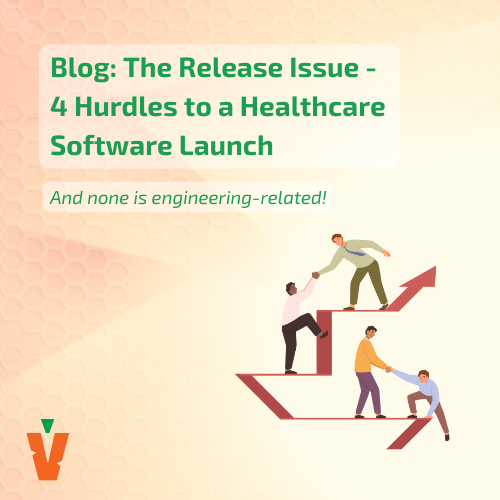Did you know that software stability usually drops in the pre-launch stage? As healthcare tech projects approach the release date, last-minute tweaks make them prone to bugs and failures. Today, we’re discussing why this happens and how to maintain a reliable platform.
You’ve entered the home stretch, and the software release is near. But instead of relaxing, you get increasingly stressed as the system shows signs of instability. Sound familiar? You’re not alone, but the issue isn’t inevitable or impossible to fix.
Join us to learn how to keep your software stable and your team on track during pre-release.
Why Does Healthcare Software Become Unstable Pre-Release?
Software stability is essential in the high-stakes healthcare industries — misbehaving apps could put PHI, finances, and even lives at risk. Still, despite the careful work of your development team, some instabilities almost always appear pre-release, as we’ve found from working on more than 60 successful projects. Why is that so?
- Increased activity and changes. As the software release date approaches, teams fix bugs and often alter some features. Doing so leads to new bugs if the modifications are hastily made.
- Integration challenges. The final stages of development involve putting various components of the software together. There might be instability while you’re integrating different parts of the system.
- Higher user loads. Pre-release testing includes simulating high loads to ensure the system can handle real-world usage. It can reveal bottlenecks that weren’t apparent during early development.
- Environment differences. The pre-release environment may differ from the production environment in subtle ways, leading to issues only becoming apparent when you’re about to go live. These differences include hardware, network configurations, and data sets.
- Last-minute scope creep. Pressure to include additional features just before launch can disrupt software stability. Late-stage additions rarely go through the same rigorous testing as earlier functionalities.
If you don’t account for these issues, you’ll see delays, added costs, and burnout in your team. Luckily, there’s an easy way to keep instability in check — and it starts with monitoring and focusing on objective facts.
As the lead executive, it’s on you to keep the board and stakeholders informed, calm, and confident in your abilities to deliver quality software. But you don’t have to do it alone — the CTO is an invaluable resource to manage the tech teams dealing with the bugs. As another board member, they’ll be able to fight fires that occur due to perceived instability.
Another good practice is to seek regular updates from the triaging team. Create an update form that gets sent to the stakeholders daily to maintain transparency and prevent panicking. As long as they see issues getting caught and resolved, the pre-launch stage will remain (relatively) free of stress and drama.
As a final point, know that some instabilities are more severe than others. They might even delay the launch date — but resolving them before the release is better than having to fix them in post. Take a decisive leadership role and move the deadline if necessary, presenting a clear plan that ensures the new date is reliable.
To take any of these steps, you need a way to monitor software stability. And the best way to do that is through monitoring tools.
Best Software Stability Monitoring Tools
Everybody’s stressed in late development, but subjective impressions and finger-pointing once you catch a bug only increases the chaos. Instead, as the leader, you should ask for objective status reports on system health. Think of your product as a patient in the ER, connected to various monitors that provide real-time data on its vital signs. Similarly, your product should be under constant scrutiny through specialized uptime and APM software tools.
Here are the top suggestions by the Vitamin development team.
Uptime Monitoring Tools
Tools like Pingdom and UptimeRobot provide status checks and automated smoke tests to determine if the system is operational and if essential features function as expected throughout the day. These tools give you a binary insight into the system’s health — it’s either alive or not.
These solutions send status reports that show if a platform is accessible from various locations or networks. They immediately catch unexpected downtime and measure response times.
Smoke tests verify whether the critical functions are working correctly. They cover core features crucial for basic operations and user interactions. We typically run them shortly after a new build or code deployment to catch experience-breaking issues.
APM Software
Application performance monitoring (APM) software offers deeper insights. It tells you how well the system is performing, even if it’s technically operational. For instance, New Relic or Datadog can reveal bottlenecks and UI issues that aren’t immediately apparent but could affect usability.
When APM software detects an anomaly, it reports to a team of SREs (Software Reliability Engineers).
The SRE team manually evaluates each alert to determine whether they indicate genuine bugs or false positives/negatives. They differentiate between issues that require immediate attention and benign anomalies that can be ignored. Once an alert is confirmed as a genuine issue, the SRE updates the status page to reflect the incident.
You can also achieve reliability with APM software. Have a live page showing the status of various features to maintain transparency, but remember to only update it after evaluation by the SRE. This practice prevents panic among users and the risk of exposing potential liabilities prematurely, a concern that led some companies to avoid real-time status reporting altogether.
Practical Steps to Manage Instability
Increasing software stability as you prepare to launch requires two ingredients: a culture of transparency and a thorough response plan.
Instability is a natural part of development, especially towards the end, and blaming engineers helps nobody. Instead, use objective status reports to find out how your software’s doing. Have your team provide as much information as possible — vague answers and blame-passing is a huge waste of time.
Then comes the response plan. It should outline the steps your team will take when issues arise, ensuring a structured approach to problem-solving.
- It should start with clear identification of what constitutes an instability. This includes understanding the symptoms and potential impact on users — for instance, if the underlying infrastructure makes the button malfunction, the staff of a hospital can’t log new entries. This is a real problem that needs fixing before deployment.
- When you find instabilities, the response team swings into action. This means prioritizing the issues based on severity and potential impact on patient care.
- Then comes the actual fixing part. It involves rolling out patches or updates to address instabilities. Make sure the fixes are thorough and won’t cause more problems down the line — automated regression testing should be front-and-center of this strategy.
Document the issues, the fixes applied, and lessons learned along the way. It’s like creating a software stability logbook for future reference.
.png?width=400&height=220&name=Pro%20tip%20VS%20(5).png)
A Word on the Role of Leadership
CEOs should take an active interest in system monitoring and ask about the processes to ensure software stability. This information lets you allocate resources to where they’re needed, renegotiate deadlines, and move the launch date if necessary. Bugs get addressed before they escalate, ensuring minimal disruptions to the software release and less drama with the board of directors.
One good way to achieve this is by relying on your CTO — after all, they’re your chief technical adviser. They’re also the best person to balance the business side of things with strong technical knowledge, so they should be the one overseeing the triaging team. Have one-on-one meetings with them, so you’re aware of everything that’s happening even if you yourself lack the tech expertise to understand the nuances.
At Vitamin, we have weekly executive reports whenever we build software for another organization. That way, the client’s top brass can take the next steps in whatever direction they see fit. Internally, our CEO has one-on-ones with the CTO and every PM to keep his finger on the pulse of all projects.
Key Takeaways on Healthcare Software Stability
The final push before a software launch can be stressful, but it’s manageable with monitoring tools, human oversight, and proactive leadership.
Remember, the key is to treat your software like a patient — constant monitoring, accurate diagnosis, and timely intervention are critical to its health and success. The software releases will go much smoother once you adopt this approach.
Need help dealing with pre-launch bugs or developing a response plan for software stability? Schedule a consultation, and we can walk you through our approach or step in to offer hands-on assistance.
.png)

.png)

.png)